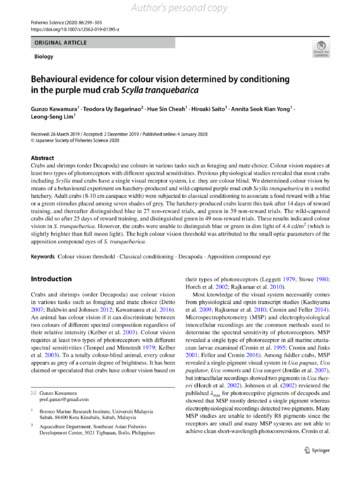Behavioural evidence for colour vision determined by conditioning in the purple mud crab Scylla tranquebarica
- Global styles
- MLA
- Vancouver
- Elsevier - Harvard
- APA
- Help
Share
Abstract
Crabs and shrimps (order Decapoda) use colours in various tasks such as foraging and mate choice. Colour vision requires at least two types of photoreceptors with different spectral sensitivities. Previous physiological studies revealed that most crabs including Scylla mud crabs have a single visual receptor system, i.e. they are colour blind. We determined colour vision by means of a behavioural experiment on hatchery-produced and wild-captured purple mud crab Scylla tranquebarica in a roofed hatchery. Adult crabs (8-10 cm carapace width) were subjected to classical conditioning to associate a food reward with a blue or a green stimulus placed among seven shades of grey. The hatchery-produced crabs learnt this task after 14 days of reward training, and thereafter distinguished blue in 27 non-reward trials, and green in 39 non-reward trials. The wild-captured crabs did so after 25 days of reward training, and distinguished green in 49 non-reward trials. These results indicated colour vision in S. tranquebarica. However, the crabs were unable to distinguish blue or green in dim light of 4.4 cd/m2 (which is slightly brighter than full moon light). The high colour vision threshold was attributed to the small optic parameters of the apposition compound eyes of S. tranquebarica.
Suggested Citation
Kawamura, G., Bagarinao, T., Cheah, H. S., Saito, H., Yong, A. S. K., & Lim, L.-S. (2020). Behavioural evidence for colour vision determined by conditioning in the purple mud crab Scylla tranquebarica. Fisheries Science , 86(2), 299-305. https://doi.org/10.1007/s12562-019-01395-z
Type
ArticleISSN
0919-9268; 1444-2906Collections
- Journal Articles [1258]



